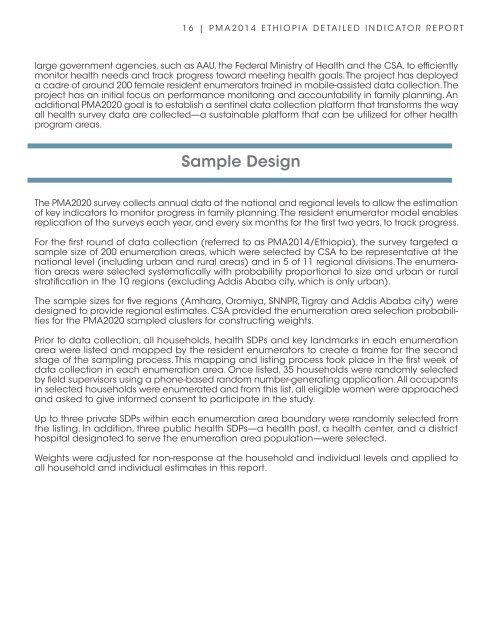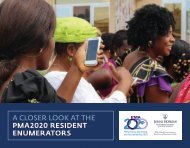1K856Ag
1K856Ag
1K856Ag
You also want an ePaper? Increase the reach of your titles
YUMPU automatically turns print PDFs into web optimized ePapers that Google loves.
16 | PMA2014 ETHIOPIA DETAILED INDICATOR REPORT<br />
large government agencies, such as AAU, the Federal Ministry of Health and the CSA, to efficiently<br />
monitor health needs and track progress toward meeting health goals. The project has deployed<br />
a cadre of around 200 female resident enumerators trained in mobile-assisted data collection. The<br />
project has an initial focus on performance monitoring and accountability in family planning. An<br />
additional PMA2020 goal is to establish a sentinel data collection platform that transforms the way<br />
all health survey data are collected—a sustainable platform that can be utilized for other health<br />
program areas.<br />
Sample Design<br />
The PMA2020 survey collects annual data at the national and regional levels to allow the estimation<br />
of key indicators to monitor progress in family planning. The resident enumerator model enables<br />
replication of the surveys each year, and every six months for the first two years, to track progress.<br />
For the first round of data collection (referred to as PMA2014/Ethiopia), the survey targeted a<br />
sample size of 200 enumeration areas, which were selected by CSA to be representative at the<br />
national level (including urban and rural areas) and in 5 of 11 regional divisions. The enumeration<br />
areas were selected systematically with probability proportional to size and urban or rural<br />
stratification in the 10 regions (excluding Addis Ababa city, which is only urban).<br />
The sample sizes for five regions (Amhara, Oromiya, SNNPR, Tigray and Addis Ababa city) were<br />
designed to provide regional estimates. CSA provided the enumeration area selection probabilities<br />
for the PMA2020 sampled clusters for constructing weights.<br />
Prior to data collection, all households, health SDPs and key landmarks in each enumeration<br />
area were listed and mapped by the resident enumerators to create a frame for the second<br />
stage of the sampling process. This mapping and listing process took place in the first week of<br />
data collection in each enumeration area. Once listed, 35 households were randomly selected<br />
by field supervisors using a phone-based random number-generating application. All occupants<br />
in selected households were enumerated and from this list, all eligible women were approached<br />
and asked to give informed consent to participate in the study.<br />
Up to three private SDPs within each enumeration area boundary were randomly selected from<br />
the listing. In addition, three public health SDPs—a health post, a health center, and a district<br />
hospital designated to serve the enumeration area population—were selected.<br />
Weights were adjusted for non-response at the household and individual levels and applied to<br />
all household and individual estimates in this report.



